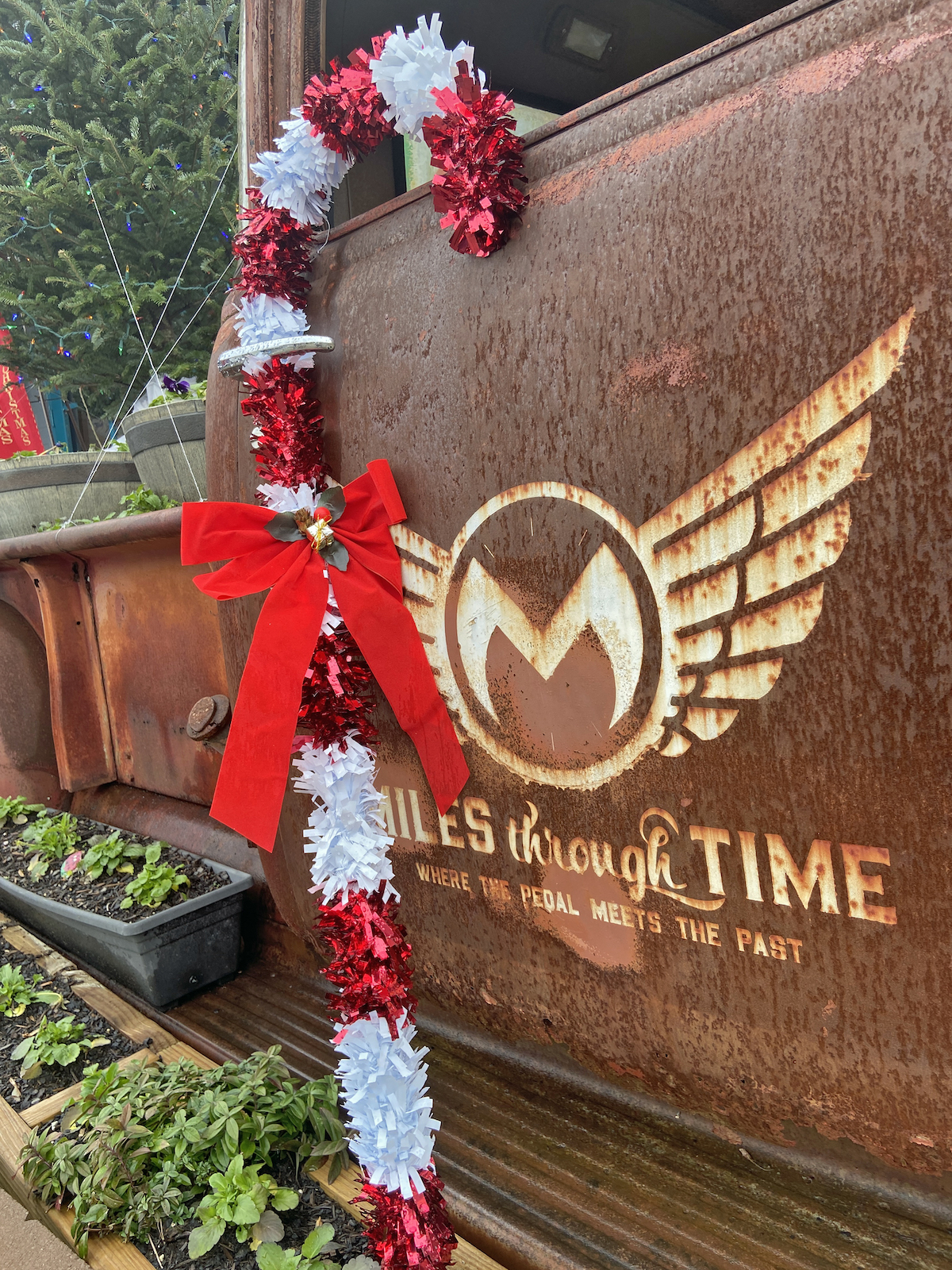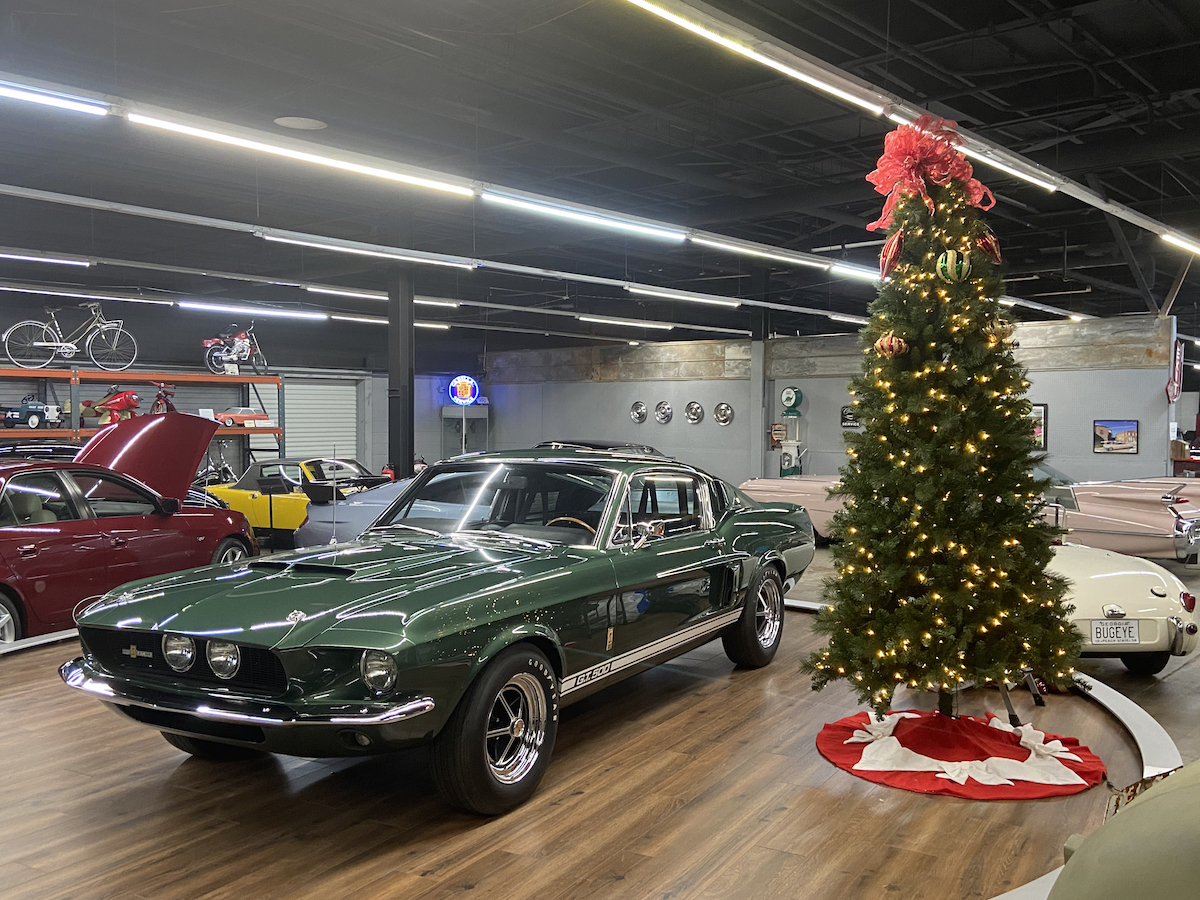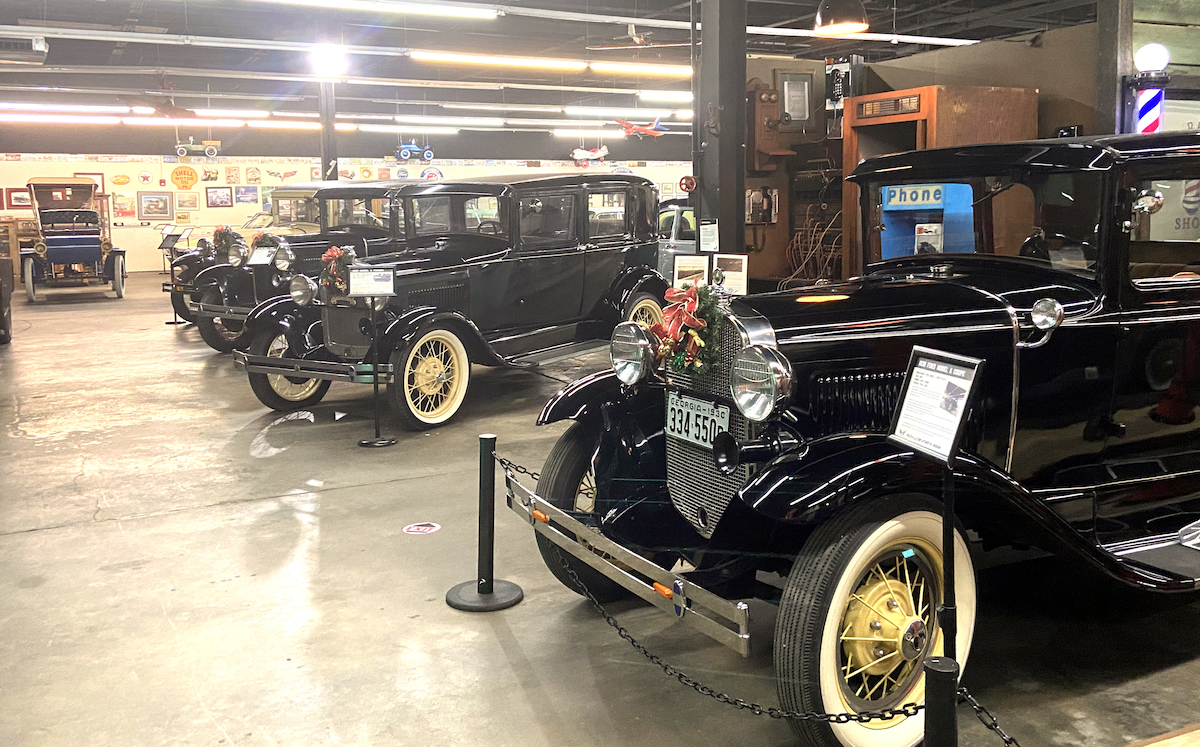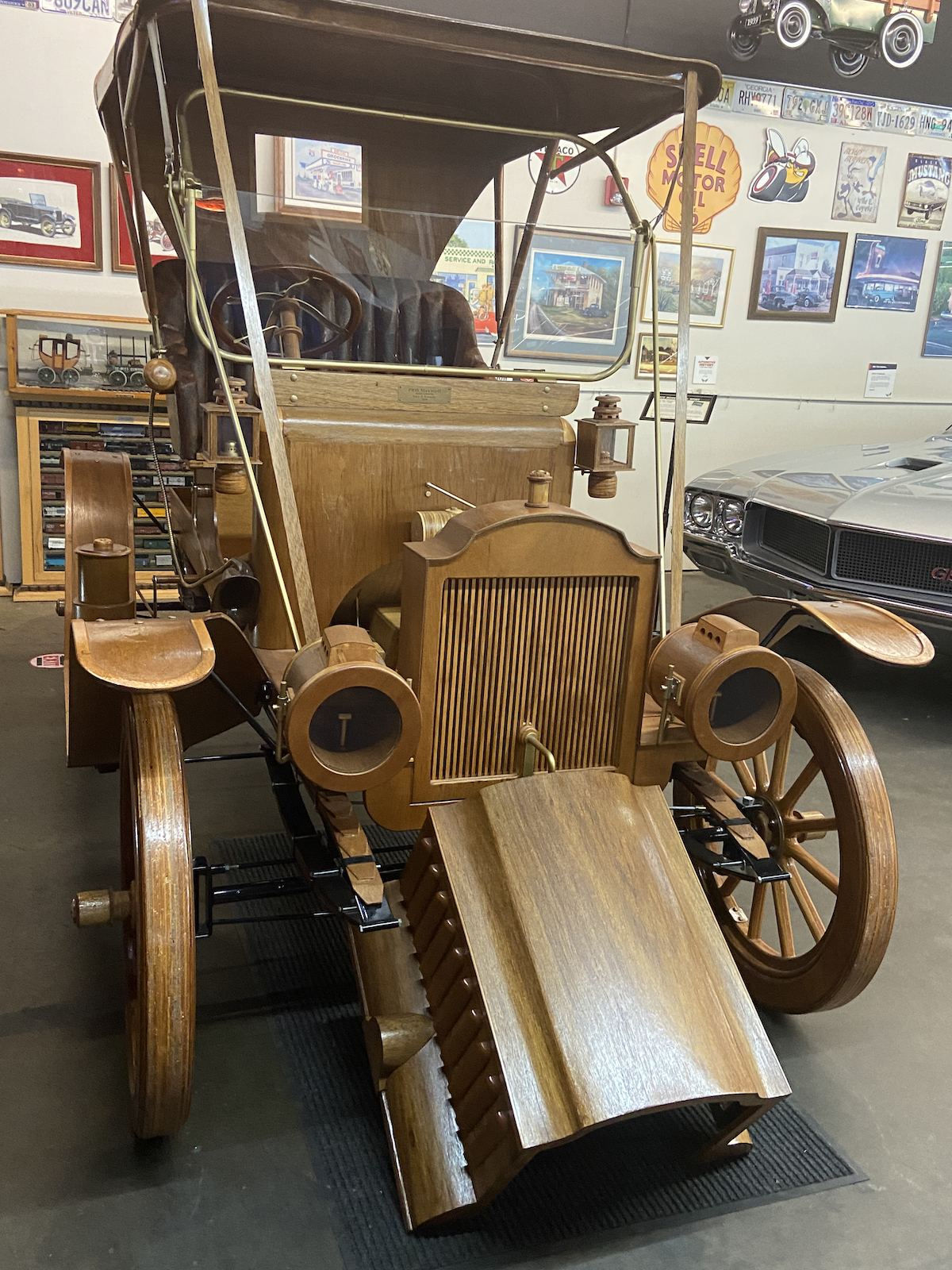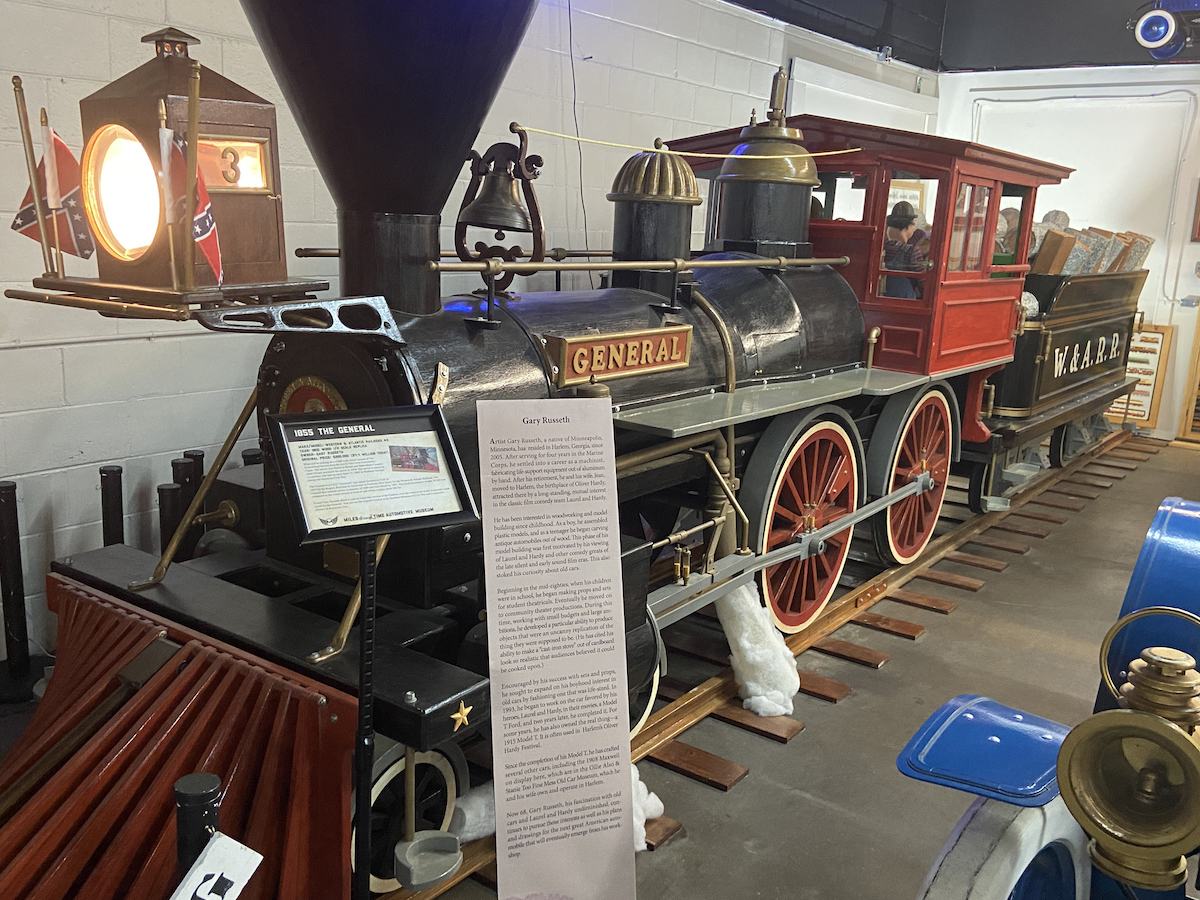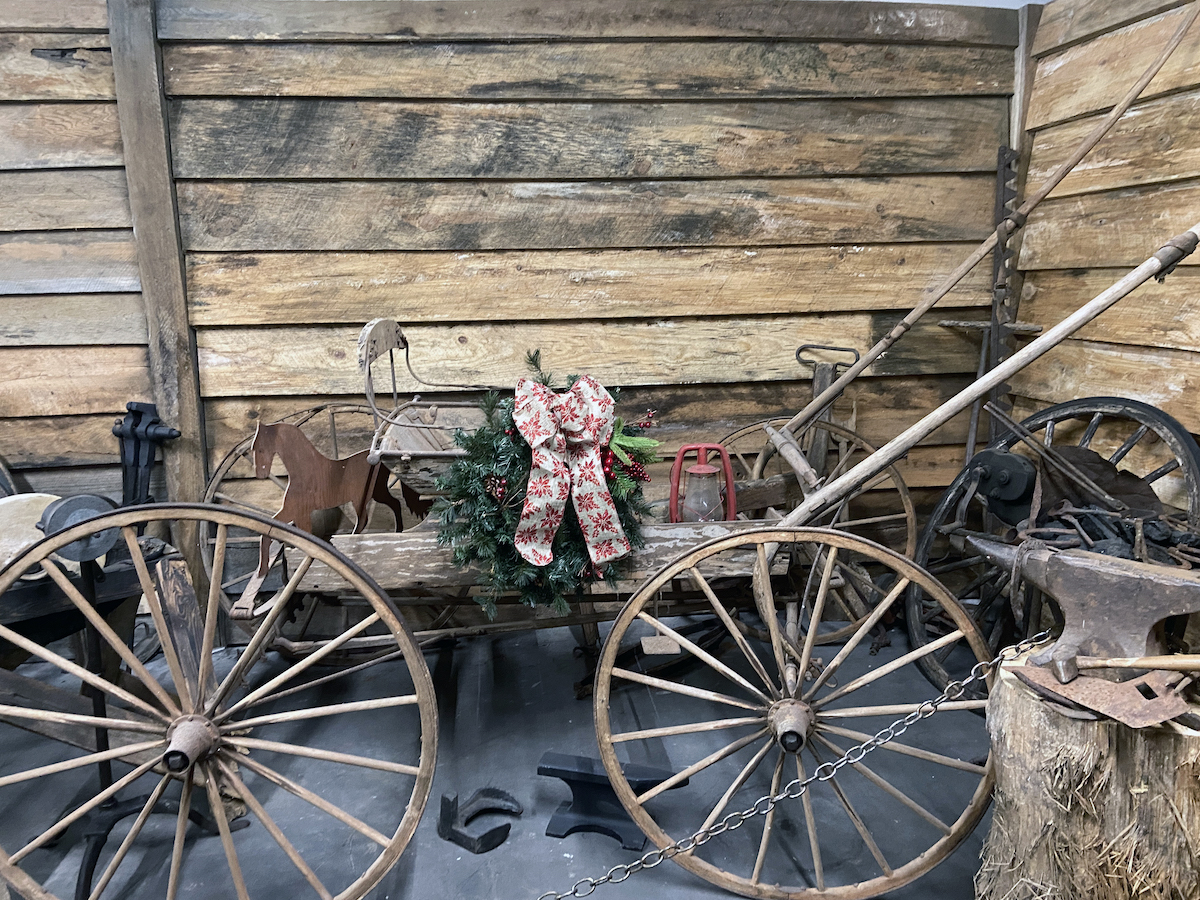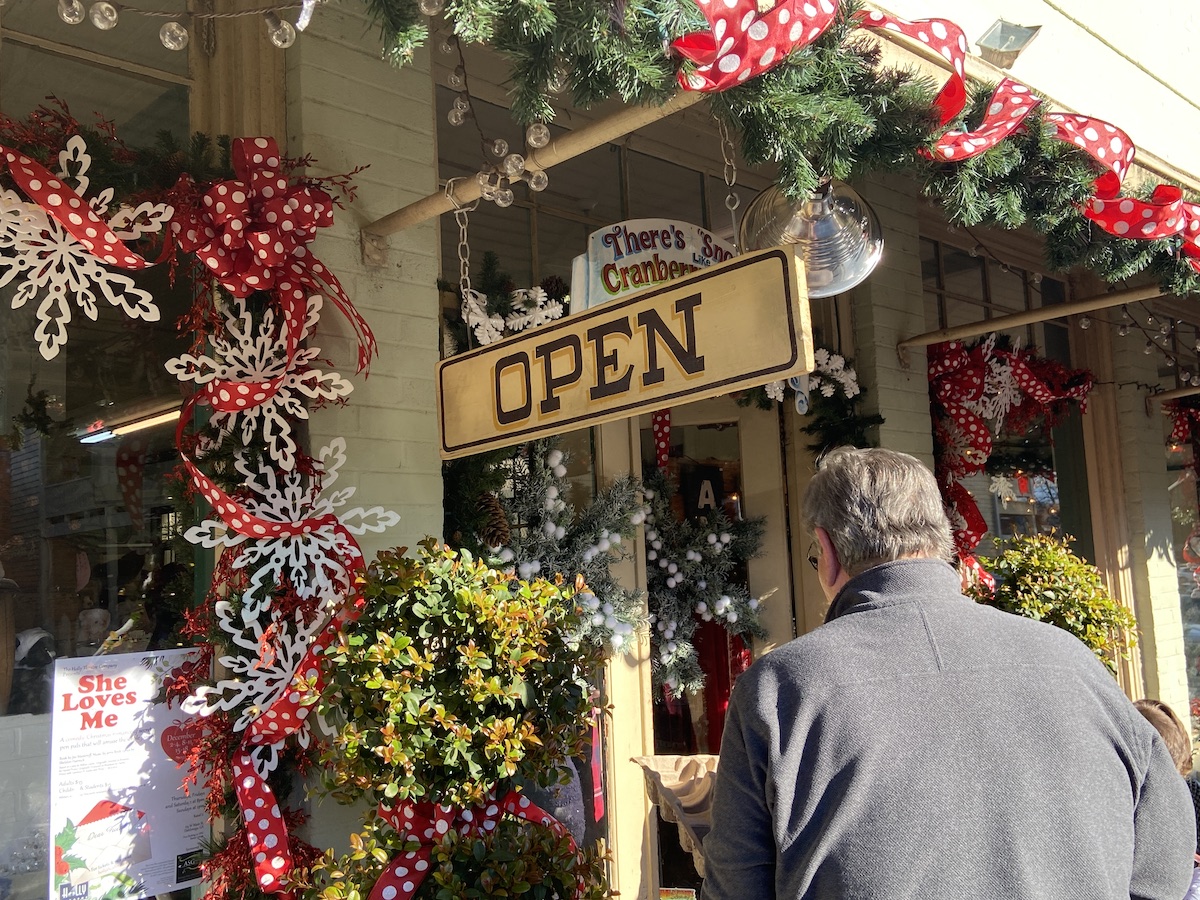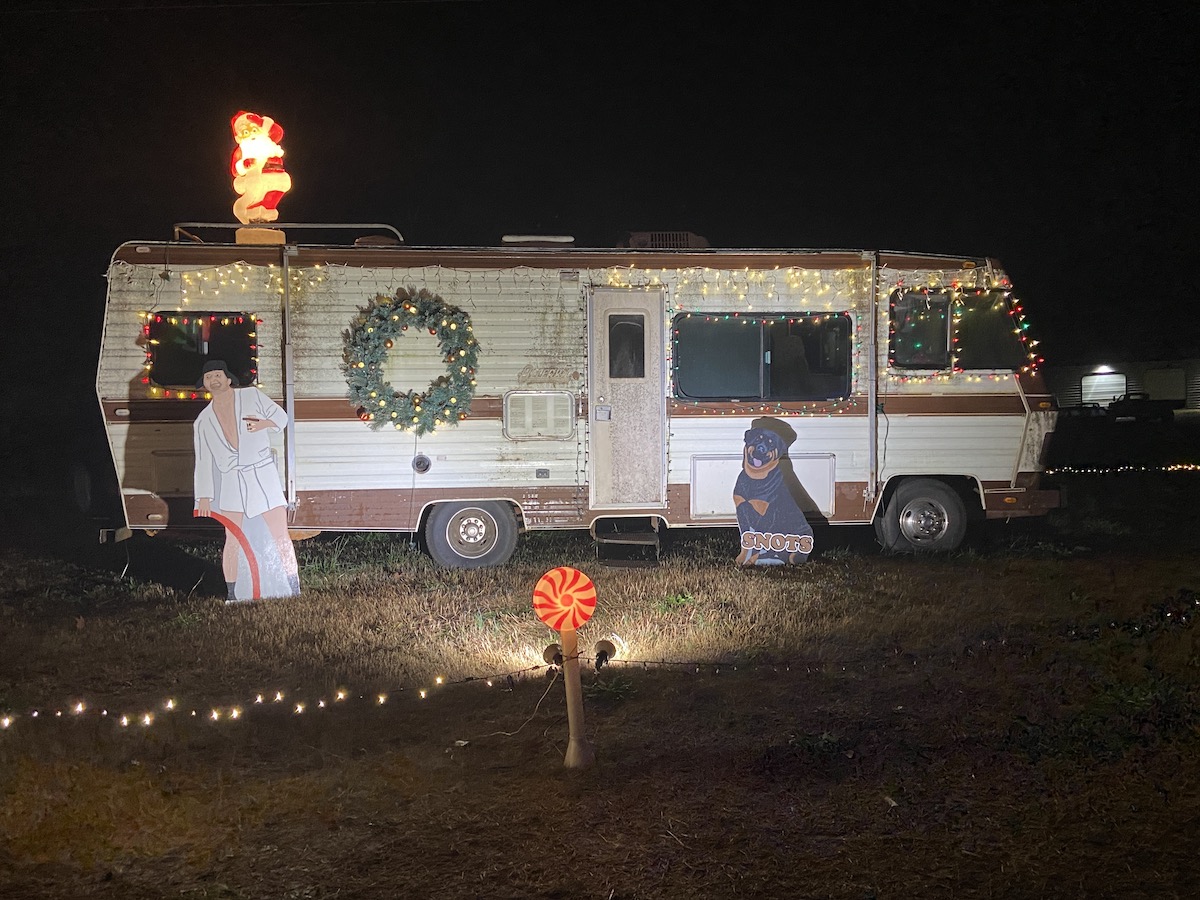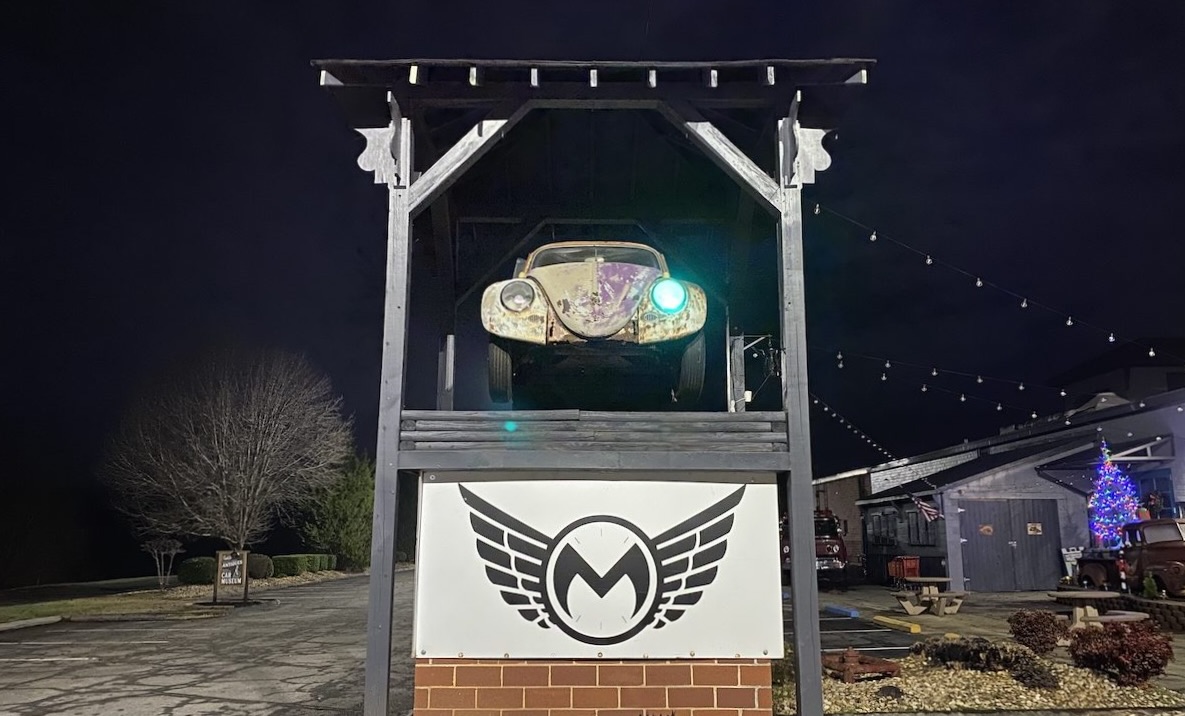
I would say that Miles Through Time Automotive Museum is hidden away at the back of the Old Clarkesville Mill, but it’s hard to be stealthy with a Volkswagen Bug with neon flashing headlights perched on a pole some 15 feet above the entrance.
Through the doors, before finding my way into the expansive hall filled with more than 100 years of automotive history, I had a chance to wander through dozens of vendor booths in Vintage Garage Antiques – a sister venture for MTT owner Sean Mathis.
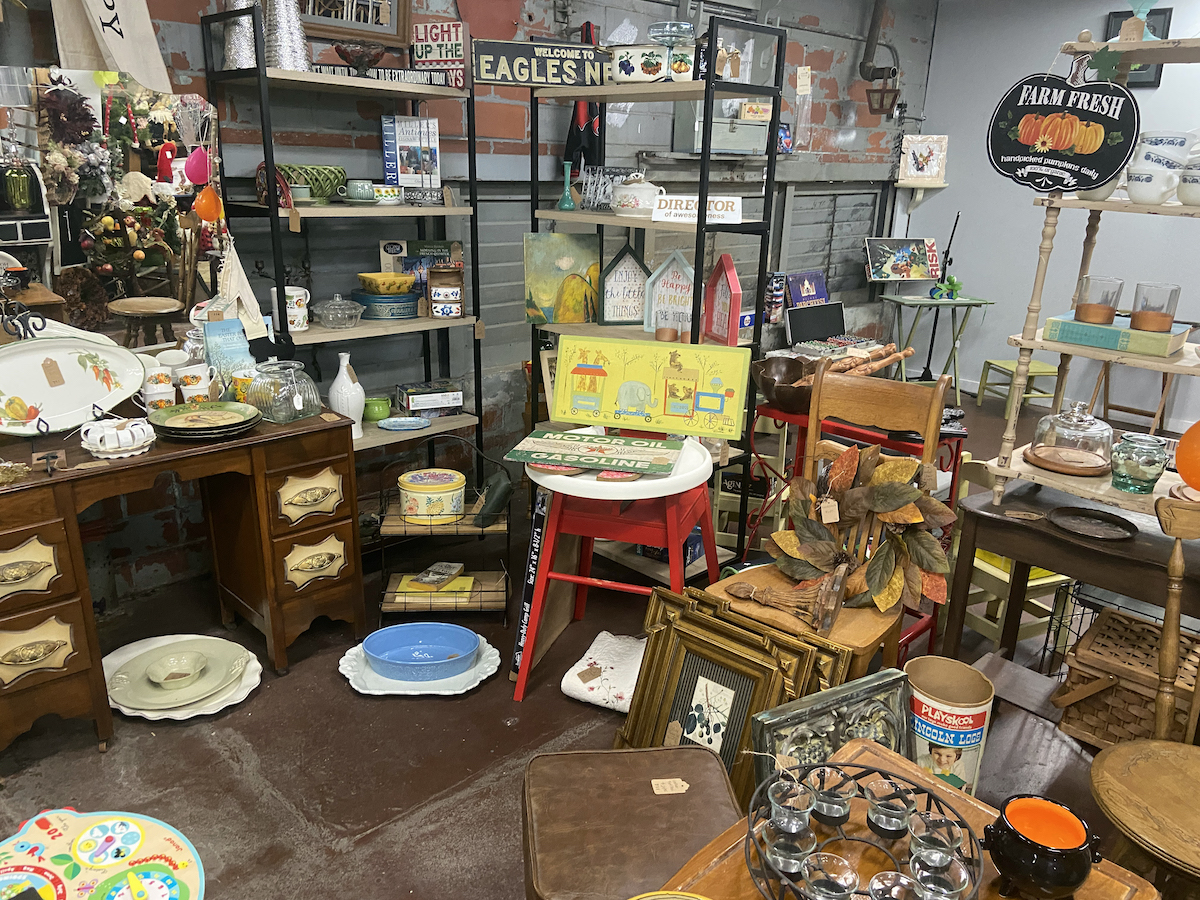
Vintage Garage Antiques is a more recent addition to Mathis’ museum and helps provide financial support for the 501-c-3 museum. In addition, the constantly-changing variety of antiques, knick-knacks, collectibles, and crafts carefully laid out in each vendor’s section provides walk-in traffic for the museum, which is Mathis’ passion.
“Our whole point is, if you’re a car enthusiast, from any spectrum, you’re welcome. The whole idea of this … the museum, the cruise-in … it is all to bring everyone together and to pass the knowledge along,” Mathis told Now Habersham as he showed us around the museum, packed with decades of memorabilia and actual automobiles — from the days of horse and buggy to Model Ts and Model As, to cars from the 30s, muscle cars and even a 2022 Ford Mustang Shelby GT 500, sitting alongside a Shelby actually owned by Carroll Shelby himself.
MTT is more than just one person’s car collection and is different from big corporate museums, Mathis explained. Every vehicle in the museum is privately owned – several have been donated to the museum, but the rest are privately owned and are on temporary loan – which means they will be replaced with other displays.
“There is always something new, you never know when we’re going to be bringing something new through the door,” he said. “In addition to cars, the museum contains everything from a replica of the very first Phillips 66 filling station, a camera collection, motorcycles, and even an airplane.”
“There is something for everyone,” said JennyPhillips, who mans the entrance to the museum and manages Vintage Garage Antiques on a daily basis.

Just as important to Mathis, MTT is a place where conversations happen, interests are shared, and a community is built.
“I’ve always been a car guy. I inherited my grandpa’s car and felt so privileged to own it, I wanted to share it with people,” Mathis said. “This is built to outlast me, though. The idea is to get more people involved in preserving this history.”
And this coming weekend is a good time to get to know that community and the museum.
On Saturday, Dec. 10, starting at 11 a.m., Vintage Garage Antiques will be hosting a cruise-in and chili cookoff as a part of their Toys for Tots drive and First Responder weekend. Visit the website to learn more about the Museum and Vintage Garage Antiques and to learn how to join the cruise-in and chili cookoff.
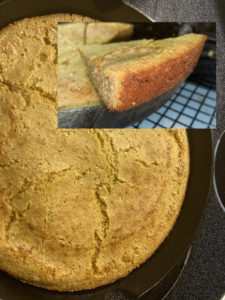
Chili & Cornbread – Texas style
Chili has never been a dish I have spent much time with, but in honor of the upcoming cookoff, I thought I’d share my grandfather’s chili and cornbread recipes. They are, I am sure, quite different from what many southerners are used to.
Texas may be as far south as you can get… but there is a big difference, in many ways, between “southern” and “south!”
*Disclaimer – Papaw made his cowboy chili and cornbread over a campfire (he was even known to make his chili right in the campfire coffee pot). I’ve tried to keep as true as possible to his ingredients and methods but used my own cooking experience and some online research to update the handed-down verbal “how-tos” into recipes that accommodate today’s ingredients, equipment, and serving sizes. Secondary Disclaimer – I make no claim to or proceed under any pretense of health consciousness for this week’s recipes. You will probably notice that my recipes and culinary travels will either be super healthy or completely ignore the dictates of healthy eating. Food, as with life, rarely occupies middle ground.
Cast Iron Skillet Cornbread
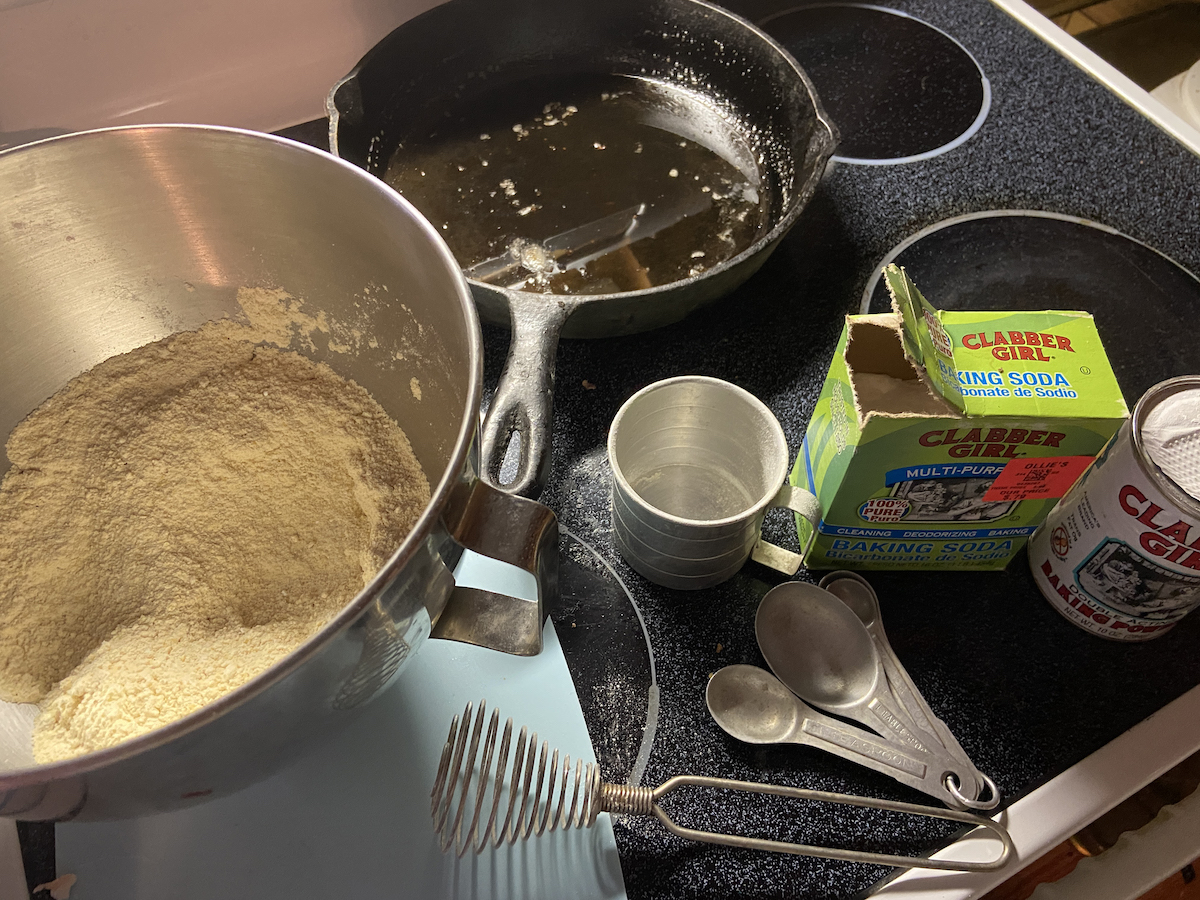
What you’ll need
Several slices of bacon
2 cups ground cornmeal
1 tsp baking powder
1 tsp baking soda
1 tsp kosher salt
2 large eggs
1 ½ cups buttermilk
Heat oven to 400℉
- Cook up 4 or 5 slices of bacon, reserve 2 tablespoons of bacon grease, and then put the skillet in the oven to keep warm. (Bacon is not used in this recipe, just the grease. If you don’t want to cook the bacon, thoroughly grease the bottom and sides of the pan and put it in the oven) You want the skillet and the coating of grease to be hot when you add the batter so that the edges crisp up immediately and the cornbread does not just sit in any oil, soaking it up, making for soggy, oily, sad cornbread)
- In a mixing bowl, combine 2 cups ground cornmeal, 1 tsp baking powder, 1 tsp baking soda, and 1 tsp kosher salt (or ½ tsp table salt). Stir with fork to combine.
- In another bowl, whisk together 2 large eggs, 1 ½ cups buttermilk, and the 2 tablespoons of cooled, but still liquid, bacon grease (substitute 2 tbs melted Crisco, or 2 Tbs vegetable oil if you did not cook bacon).
- Add the cornmeal mix to the buttermilk mix, stirring as you add. Mix with a fork just until blended. Break up any large lumps, but do not overmix (there will still be small lumps).
- Remove the pan from the oven (please do not burn yourself!) and immediately pour the cornmeal batter into the pan. Place the pan back in the oven and bake for 20-25 minutes. (A wooden toothpick inserted in the middle will come out clean).
- Let cool before cutting, and use a metal spatula to remove slices from the pan. (Depending on how well seasoned your cast iron pan is, it may or may not stick.)
Note: Texas cornbread does not have a cake-like consistency (just like Texas chili doesn’t have beans or tomatoes), nor does it have any sweeteners included in the preparation, but if you want dessert, just take the cornbread and dip it in, or drizzle it with honey, maple syrup, or my favorite, blackstrap molasses.
Texas cowhand campfire chili
serves about 4
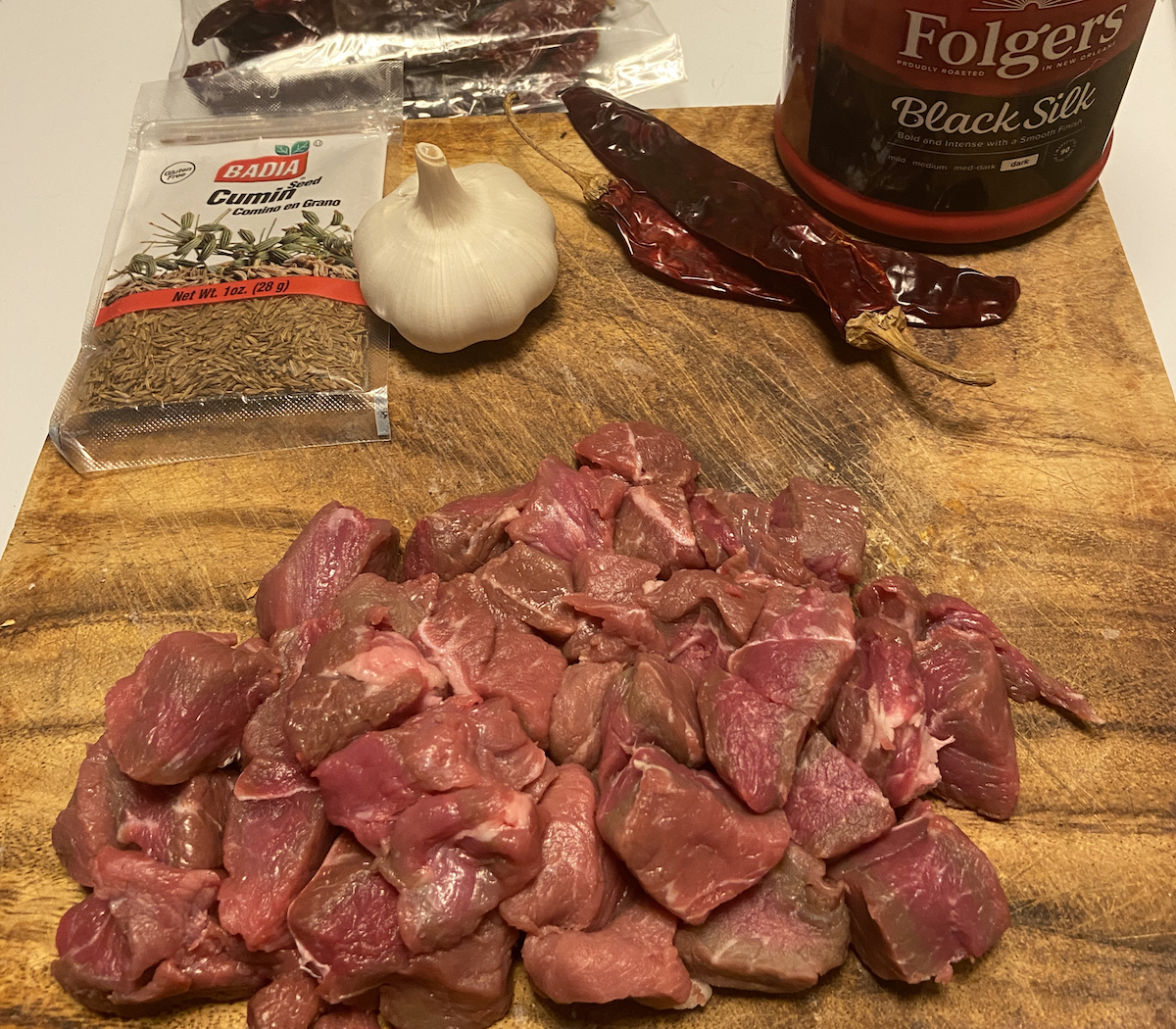
What you’ll need:
1 cup dark brewed coffee
3 cups water
6 dried chiles
2 Lbs beef, cubed
2 tsp. salt
1 tsp. fresh ground black pepper
2-6 Tbs vegetable oil
½ large onion, diced
2-3 large fresh peppers, chopped (Jalapinos for milder, serrano for hotter, or some of each)
6 cloves garlic, crushed
2 tsp. Mexican oregano
2 Tbs. cumin seed, toasted and crushed (or 1 Tbs. cumin powder)
1 Tbs. Masa Harina
- Add coffee and water to a saucepan and bring to a boil over medium high heat while you prepare chiles.
- Prepare chiles. With scissors or a sharp knife, cut off the stem and cut open each chile from top to bottom. Brush, shake or tap the seeds out and discard. In a dry cast iron skillet, toast chiles over medium-low heat for 2 minutes per side. Do not char, as that can make some types of chiles bitter.
- Add chiles to the saucepan with boiling water and coffee. Turn heat off, cover pan, and let sit for 30 minutes.
- Place chiles and ¼ – ½ cup of the coffee/water mix (reserve remaining liquid) in a blender (or a Ninja-type processor) and blend until the chile skins have been completely incorporated and the mixture is a paste the consistency of heavy cream. Add a few more tablespoons of soaking liquid if needed. Set aside.
- Toss beef cubes with 2 tsp. salt and 1 tsp. fresh ground black pepper. In the skillet that you toasted the chiles in, bring 2 Tbs. vegetable oil to medium high heat, and drop half of the beef cubes into the skillet to sear for about 3 minutes per side (about 1 song on the radio, per side). Do not stir them; you want them to get a nice brown crust on each side, without cooking them through, as they will get plenty of cooking when simmering. Put them in, leave them for 3 minutes (lower heat slightly and stir briefly if you see they are burning!), then use a spatula and flip them over, and leave them on the other side for 3 minutes. Remove with a slotted spoon/spatula or tongs to a clean plate and add enough oil to do the same with the second batch of beef cubes, making sure to let the oil heat in the pan before adding the second batch of beef so that the beef sears in the oil, instead of absorbing the oil.
- Lower the heat to medium low, and add an additional tablespoon of vegetable oil to the skillet. Add onions and jalapeno/serrano peppers and saute, scraping the bottom of the skillet with the spatula to loosen browned beef bits. After 3-4 minutes, when onions begin to soften, add garlic and saute for 2 more minutes. Stir in cumin and oregano during the last 30 seconds.
- Add browned beef and chile paste to skillet and heat over medium-high heat until bubbling. Lower temperature to low and stir gently until at a low simmer (barely any bubbles breaking the surface). Cover skillet and simmer for 2 ½ hours. Remove lid and stir. Simmer for 30 more minutes.
- Let sit for 30 minutes, allowing beef to soak up liquid. Sauce should be thick, coating meat. If chili looks dry, add ¼ cup beef stock or water, and simmer 10 more minutes. If chili remains too liquid after cooling 30 minutes, stir in 1 Tbs. masa harina.
- Serve with cornbread. Or let cool, cover, and refrigerate overnight. Chili, like spaghetti, is always better the second day!

Ingredients notes:
Meat: Chuck roast with only light marbling (do not use Prime grade, it contains more marbling) is a good choice for chili con carne. If it’s too tender, it will fall apart during cooking and you’ll have sloppy Joes, not chili with chunks of meat!
Chuck has good flavor, but is too tough without long cooking, so is not appropriate for many other dishes, and can often be found for a cheaper price than other cuts.
Chiles: Using a paste you make fresh from dried chiles will result in a fresher, more flavorful chili than using chili powder. Use the type of chiles you include in order to determine the heat of your chili; trying to increase the heat by increasing the number of chiles will cause the chile flavor to overpower the flavor of the meat. The addition of fresh jalapeno and/or serrano peppers will also allow for customization of the spiciness. You can use six of the same chiles, or combine different types of chiles to influence the heat and the flavor. Here are some of the more commonly-available dried chiles – most available at local grocery stores. If you choose to use chili powder, eliminate chiles, cumin and oregano and add ½ cup chili powder (more or less, to taste) at the same time you add the cumin.
Ancho Chiles (dried poblano peppers) Mild – 1,000-1,500 SHU (Scoville scale) sweet/smokey/earthy
Pasilla Chiles (dried chilaca peppers) Mild (1,000-2,500 SHU) )sweet/fruity/earthy
Guajillo Chiles (dried mirasol peppers) Medium (2,500-5,000 SHU) tangy/crisp/smokey
Chipotle Chiles (dried jalapeno peppers) Medium (2,500-8,000 SHU) smokey/earthy
Chile de Arbol Chiles (dried Arbol peppers) Medium (15,000-30,000 SHU) nutty/smokey
Cayenne Chiles (dried Cayenne peppers) Medium (30,000-50,000 SHU) neutral
Spices: Mexican Oregano is not the same as Greek oregano – it has a slightly different flavor, and is preferred for chili, but you can substitute Greek oregano 1:1.
Cumin: You can use ground cumin, but like peppers, the flavor will be better if you make your own from cumin seeds. Over medium heat in a dry skillet, heat cumin seeds for 1 minute, stirring consistently. Lower heat to low, and toast for another 2 minutes. Pour into a spice/coffee grinder or Ninja and grind in 30-second intervals until the consistency of table salt. You can also use a mortar and pestle.

